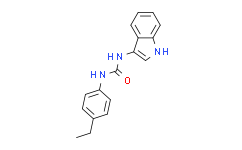| DC28013 |
Cyclic-di-GMP(c-di-GMP)
|
Cyclic di-GMP (c-di-GMP) is one of the most important and common bacterial second messenger. It is involved in numerous prokaryotic processes, including biofilm formation, motility, virulence, and cell cycling. c-di-GMP also has functions in eukaryotic cells. It is detected by the transmembrane protein stimulator of interferon genes (STING), leading to activation of the innate immune system. |
| DC28012 |
c-Di-AMP(Cyclic-Di-AMP) ammonium salt
|
Bis-(3'-5')-cyclic dimeric adenosine monophosphate (c-di-AMP) is a bacterial second messenger implicated in the control of cell wall metabolism, osmotic stress responses and sporulation.
Detection of c-di-AMP by the host cytoplasmic surveillance pathway (CSP) is known to elicit type I IFN responses through a signaling axis that involves STING, TBK1 and IRF3 [1, 2].
Involvement of the helicase DDX41 in the recognition of c-di-AMP has been suggested [3].
Recent studies have also demonstrated that c-di-AMP exerts strong adjuvant activities when delivered by the mucosal route [4, 5]. |
| DC10959 |
STING inhibitor C-178
|
STING inhibitor C-178 is a covalent, small-molecule inhibitor of STING, blocks palmitoylation (PMA)-induced clustering of STING; covalently binds to Cys91, directly targets mouse STING (mmSTING) but not human STING (hsSTING). |
| DC10960 |
STING inhibitor C-176
|
STING inhibitor C-178 is a covalent, in vivo-active, small-molecule inhibitor of STING |
| DC10908 |
ML RR-S2 CDA
|
ML RR-S2 CDA is a synthetic cyclic dinucleotide (CDN) that contains non-canonical 2'5'-phosphodiester bonds and is an activator of stimulator of interferon genes (STING). |
| DC10876 |
H-151
|
H-151(H151) is a novel STING (stimulator of interferon genes) antagonist. |
| DC12321 |
STING agonist-1 trihydrochloride
|
diABZI STING agonist-1 (trihydrochloride) is a selective stimulator of interferon genes (STING) receptor agonist. |
| DC11642 |
Cridanimod sodium
|
Cridanimod sodium is a potent type I interferon (IFN) inducer that directly binds to STING and triggers a strong antiviral response through the TBK1/IRF3 route. |
| DC11641 |
Cridanimod
|
A potent type I interferon (IFN) inducer that directly binds to STING and triggers a strong antiviral response through the TBK1/IRF3 route. |
| DC12367 |
Cyclic guanosine monophosphate-adenosine monophosphate
|
2'3'-cGAMP has been used to identify small compounds capable of binding human stimulator of interferon genes (STING). It is also used to study type I interferon response to cytosolic DNA. |






















